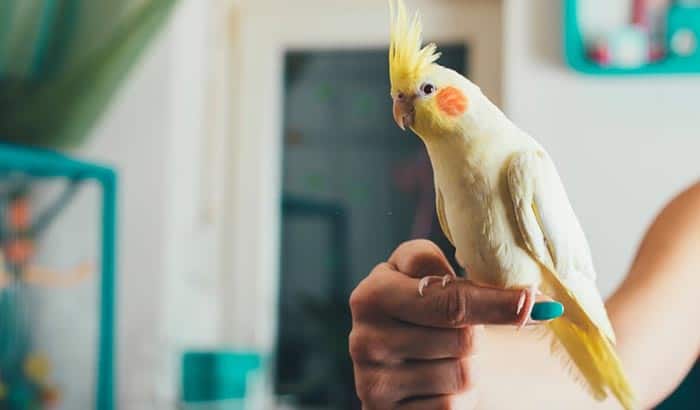Cockatiels are members of the cockatoo family and are some of the most popular companion birds, even having the record for being the No.1 pet bird in America. They are known for being bold, cuddly, and comical birds.
Being such excellent fliers makes them more in need of wing clipping than other parrot species. You wouldn’t want them to wander off as they could be easily exposed to unavoidable dangers. Here you will find out why there is a need to trim a cockatiel’s wings and the proper ways to do it.
Should you Clip your Cockatiel’s Wings?
You will not be clipping your cockatiel’s wings to prevent them from ever flying again. This is done to ensure that they won’t escape and are exposed to dangerous situations like the indoor risks mentioned above.
If done the process is done correctly, this can help your cockatiel to maintain a controlled flight down the floor. Trimming your cockatiel’s wings can prevent them from danger and make it much easier to train them.
Indoor Risks for Cockatiels
There can be many risks for cockatiels when they are set free to fly around the house. They could run into windows, walls or land into dangerous spots like the toilet or a hot stove. These could lead to many injuries like concussions or broken beaks, and maybe even death.
Is wing Clipping Cruel?
Some people believe that wing clipping is cruel and unsafe. It takes away their natural ways of moving about, getting exercise, and avoiding dangerous situations outside.
The answer varies from person to person, but what is most important is the bird’s safety. Many dangers can be avoided when you clip your bird’s wings, so although it may sound cruel, it may actually help save their lives.
Let them learn to fly before wing clipping
It is not a very good idea to clip their wings when they are still young. Wait for several weeks before deciding to clip them because if you do it too soon, they might not be able to develop the muscles they need to fly as adults.
Cockatiels who are clipped young experience injuries like breaking their tail feathers since they haven’t attained their motor skills yet. They haven’t learned how to handle their bodies for flight and landing.
Clipping Your Cockatiel’s Wings
Now that you are ready to clip your cockatiel’s wings, there are steps that you should follow for you to be able to do it correctly.
Preparing to clip your cockatiel’s wings
Before starting, find someone that can help you hold your cockatiel. It’s better to have two people for this job. To keep them from biting, have them hold it tightly and place their middle and index fingers on the sides of the cockatiel’s neck.
Make sure to have a towel at your side, especially if you have trouble controlling your cockatiel. Do not constrict the chest when restraining as it needs to breathe properly. Do this, and it may help calm your cockatiel and make it easier to handle.
The next step is to have your partner extend one of your cockatiel’s wings. The key is to be gentle and firm since its bones are fragile. Then, locate its flight feathers. Flight feathers are the long and stiff feathers that support their flight. These are found at the tip of the cockatiel’s wings. Make sure not to clip any feathers in the inner portion of the wing.
Clipping their flight feathers
Once you are prepared to clip your cockatiel’s wings, you may start clipping its feathers. The outermost four to six primary feathers are usually trimmed halfway from the base of the feather to the tip. Remember that secondary feathers and those midways from the base to the tip should not be clipped.
Start by clipping four primary flight feathers. Afterward, perform a test flight. If your cockatiel can still attain lift, you can continue by trimming one more feather from each side until it cannot lift off anymore. Once released, it should only be able to have a graceful flight to the ground.
Be aware of blood feathers
You should always be careful blood feathers. These are the developing feathers of the bird it will bleed when cut. Before wing clipping, check the shafts to ensure that you will not be cutting any blood feathers.
If you accidentally clip a blood feather, you must treat it at once. There are many ways to do this, but first, you must restrain your cockatiel. Afterward, use a cotton ball and apply pressure to the broken quill shaft to stop the bleeding.
You may apply cornstarch or flour to the surface of the quill with a cotton ball or Q-Tip. These substances should not be packed into the shaft of the feather. Keep pressing down hard until the bleeding ceases.
If the bleeding persists, you may want to see an avian vet so that they may have the feather removed.
Conclusion
Wing clipping is a process of trimming your bird’s wings to keep them safe from any harm that may come to them in your home. If your bird is startled, it could easily fly into walls or mirrors or escape from open windows. Many of them would not be able to handle themselves outside, so wing clipping could avoid certain situations like predators, cars, and other hazards.
Wing clipping will not hurt your bird if it is done correctly. You may opt to go to a veterinarian if you don’t think you are ready yet. Wing clipping is tricky and can be dangerous to your pet cockatiel if not done right. You can also look for an experienced bird breeder that can show you how to do it properly.
If you believe you are ready, make sure that you are prepared. Have someone to help you, get a towel ready, only clip four to six feathers, be aware of blood feathers, and of course, ensure proper care afterward.


